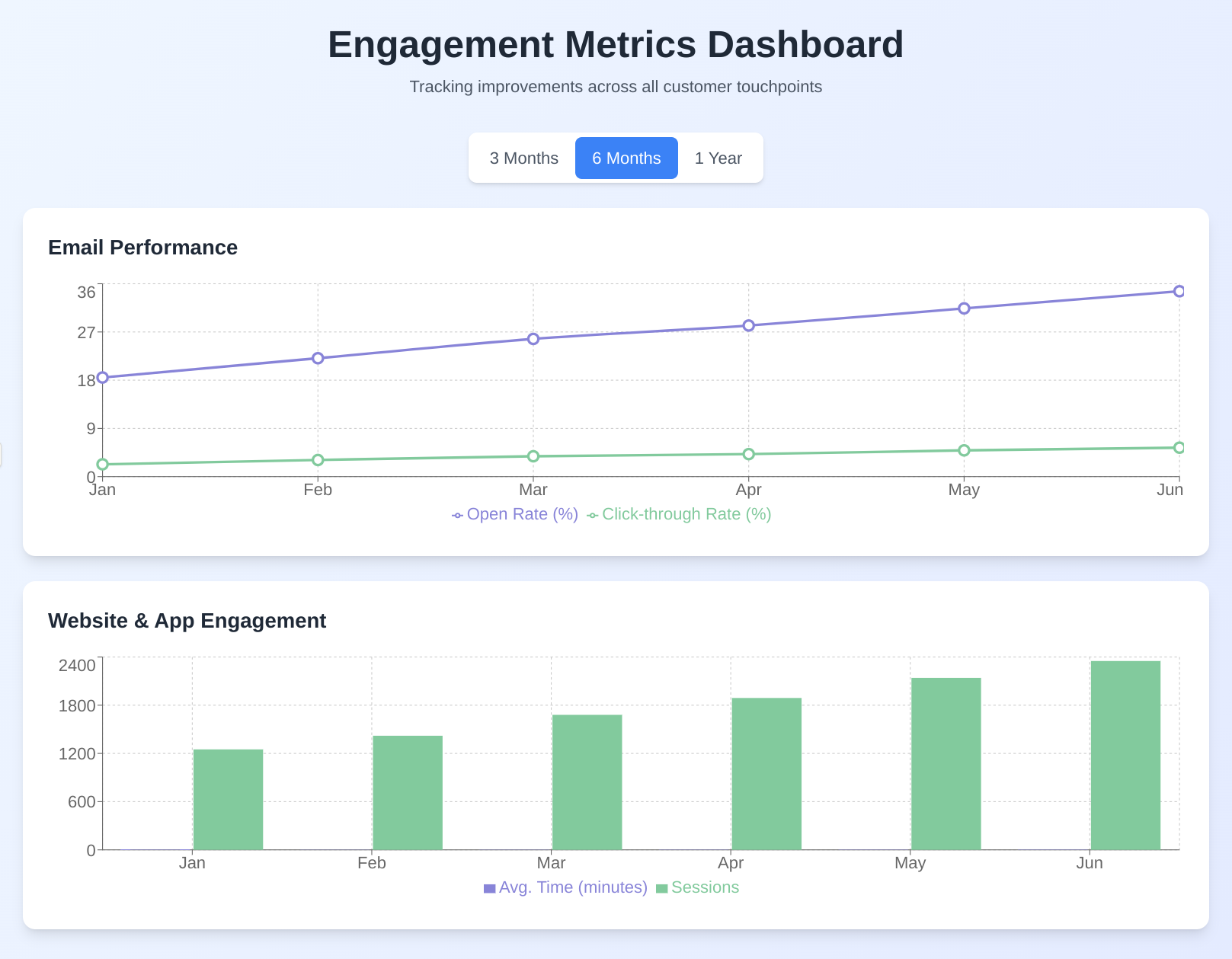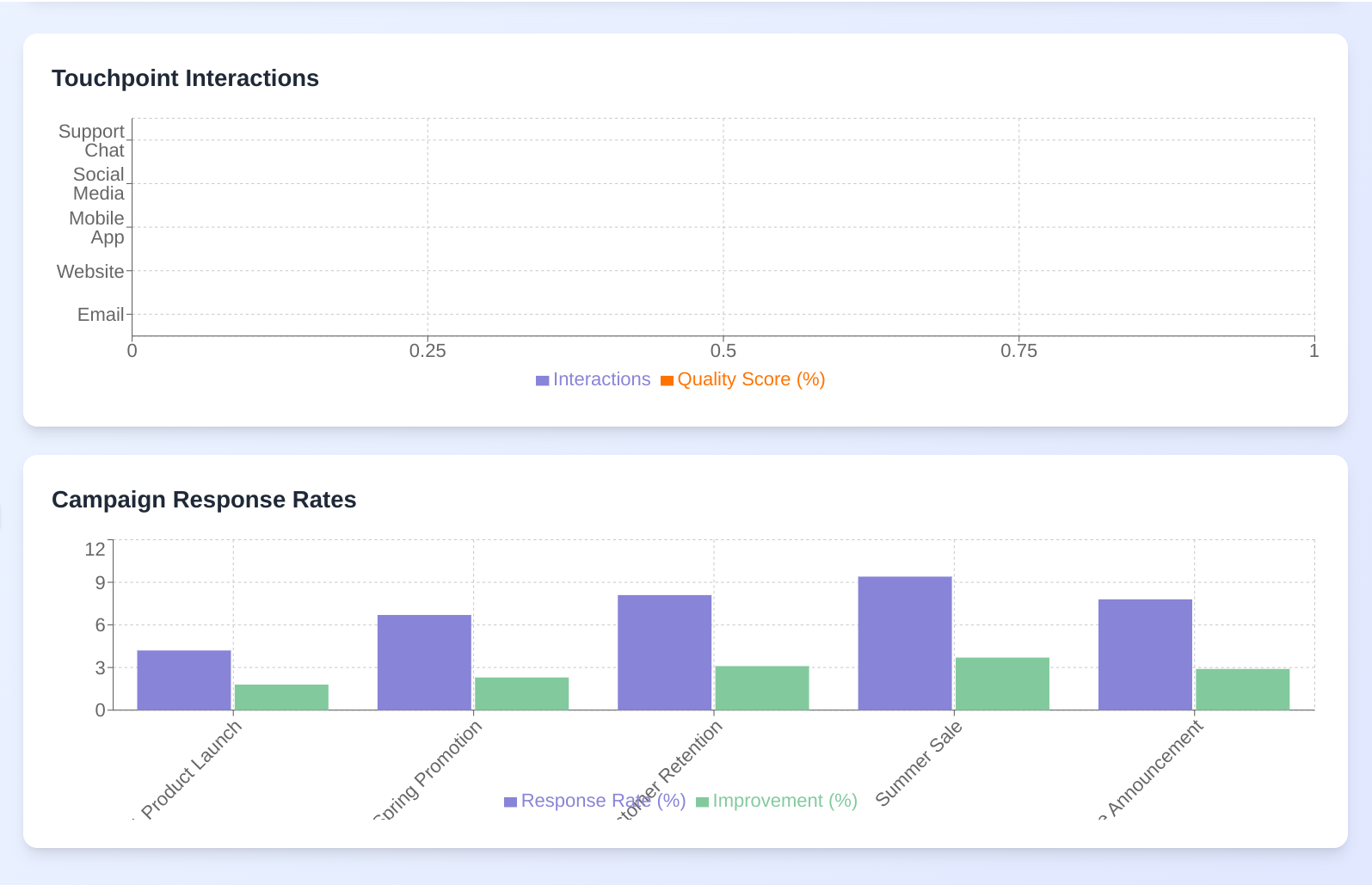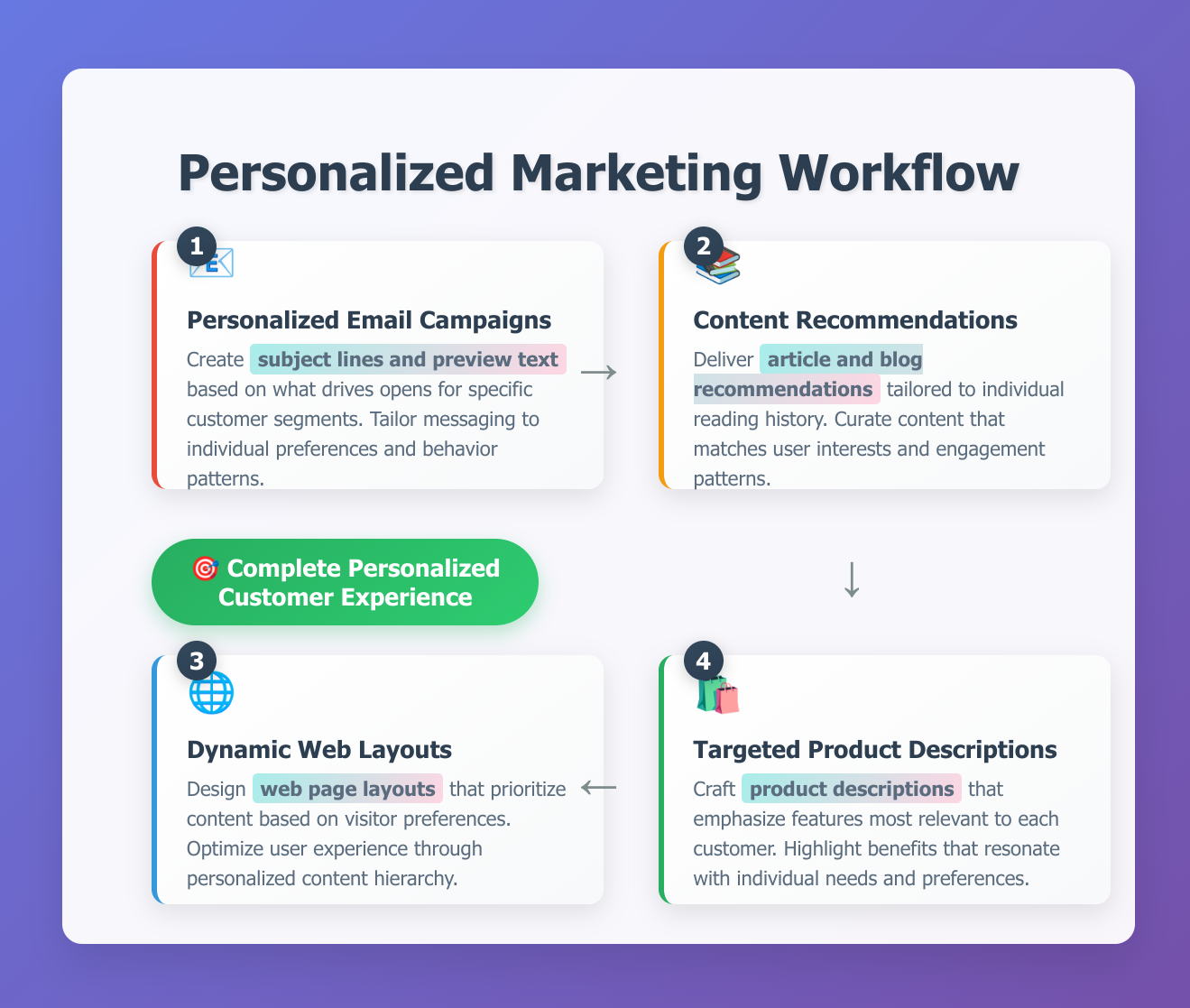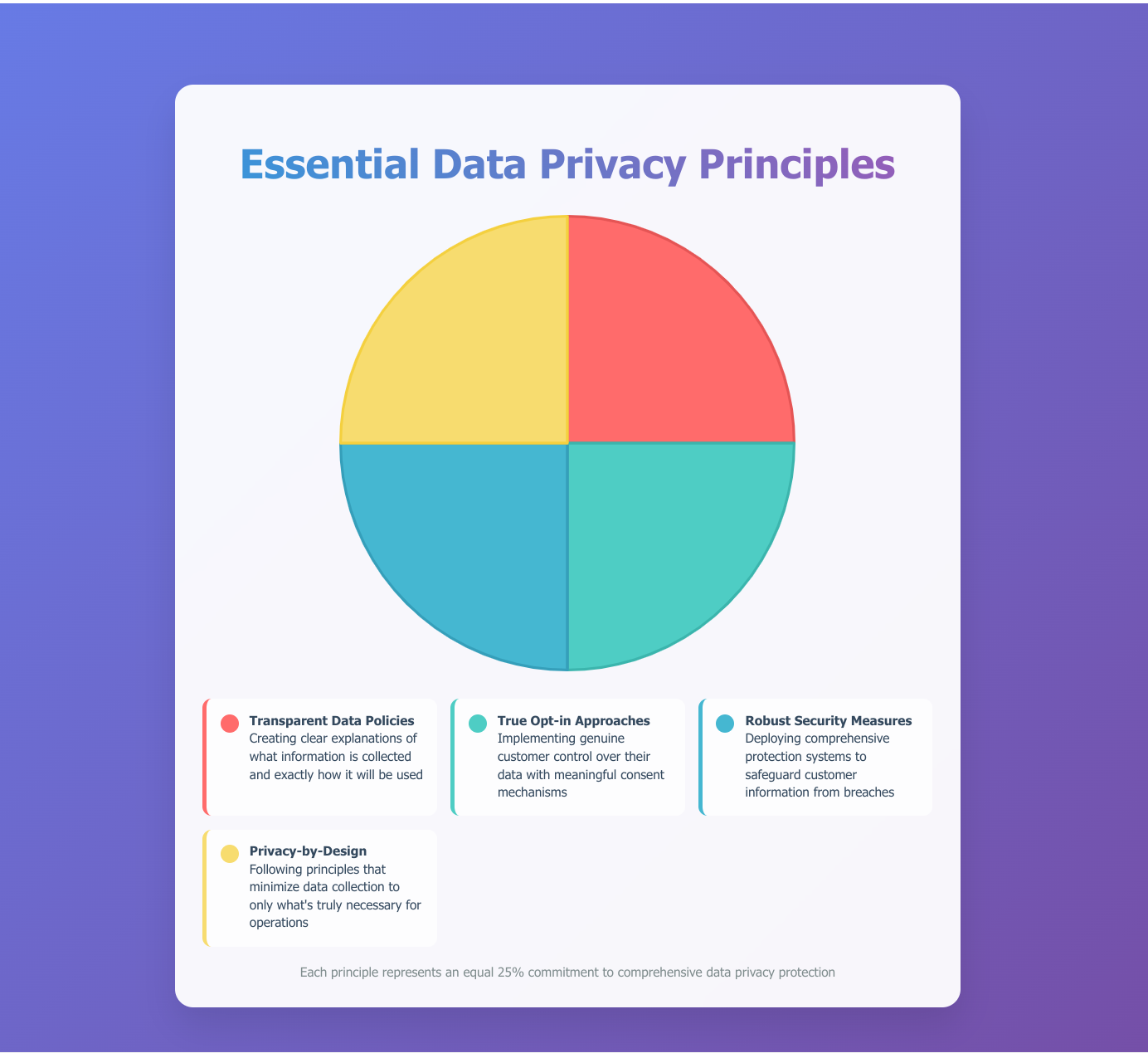AI personalization transforms marketing by analyzing real-time data to create tailored experiences that boost engagement. With 52% of customers expecting personalized offers, brands using AI can anticipate needs before they’re expressed, creating meaningful interactions that drive conversion and loyalty.
Read our latest article about customer behaviour and AI demographics here: https://amzoraltd.com/behavioral-vs-demographic-ai-marketing-for-targeting/
Key Takeaways
- AI personalization analyzes customer data from multiple sources to create tailored experiences that significantly increase engagement and conversion rates
- Implementing real-time data analysis allows brands to dynamically adapt content as customers interact with digital touchpoints
- 52% of customers now expect offers to be tailored specifically to their preferences and behaviors
- Predictive analytics powered by AI can anticipate customer needs before they express them, creating more meaningful interactions
- Amzora Limited helps businesses implement AI personalization strategies that transform standard marketing into individualized customer journeys
Revolutionizing Customer Experiences with
AI Personalization
The days of one-size-fits-all marketing are long gone. Today’s customers expect personalized experiences tailored to their unique preferences and behaviors at every touchpoint. AI personalization makes this possible at scale, transforming how brands connect with their audiences.
Content Marketing Agent specializes in helping businesses use these advanced AI technologies to create more meaningful customer interactions that drive engagement and loyalty.
How AI Powers Personalization Across
the Customer Journey
1. Real-Time Data Analysis and Pattern Recognition
AI personalization begins with comprehensive data analysis. Advanced algorithms continuously examine customer information from various sources including browsing history, purchase patterns, social media interactions, and on-site behavior. Unlike traditional analytics, AI can process this information in real-time, identifying patterns and connections that would remain invisible to human marketers.
This sophisticated analysis allows brands to understand not just what customers have done, but why they did it and what they might do next. The system becomes increasingly accurate as it processes more interactions, creating a virtuous cycle of improving personalization.
2. Dynamic Content Adaptation
With insights gathered through data analysis, AI systems automatically tailor content to match individual preferences. This happens seamlessly across websites, emails, apps, and other digital touchpoints. For example:
- A streaming service might show different thumbnail images for the same movie based on viewing history
- An e-commerce site can reorganize product categories based on browsing patterns
- Email marketing systems can adjust send times, subject lines, and content based on past engagement
These adaptations happen in real-time, creating experiences that feel intuitive and relevant to each customer. As the system learns more about individual preferences, the personalization becomes increasingly sophisticated.
3. Predictive Analytics for Anticipating Needs
The most powerful aspect of AI personalization is its ability to anticipate future customer needs. By analyzing patterns across similar customer segments, these systems can predict what products or content will resonate next. This transforms marketing from reactive to proactive, allowing brands to address customer needs before they’re even expressed.
For instance, an AI system might notice that customers who purchase a particular product often return for a complementary item within 30 days. The system can then proactively recommend that second item at the optimal moment, creating a more helpful and intuitive customer experience.
Measurable Benefits of AI Personalization Marketing
1. Increased Customer Engagement (52% Expect Tailored Offers)
Today’s consumers don’t just appreciate personalization—they demand it. Salesforce research confirms that 52% of customers now expect offers to be tailored specifically to their preferences and behaviors. When brands meet these expectations through AI-powered personalization, the results are impressive:
- Higher email open and click-through rates
- Increased time spent on websites and apps
- More frequent and meaningful interactions across all touchpoints
- Improved response rates to marketing campaigns
These engagement improvements translate directly into stronger customer relationships. When someone feels that a brand truly understands their needs, they’re naturally more inclined to pay attention to what that brand has to say.
Below are some examples of the type of engagement data gathering possible:



2. Enhanced Brand Loyalty and Reduced Churn
Personalization creates emotional connections that basic marketing simply cannot match. When customers consistently receive relevant recommendations, timely offers, and content that speaks directly to their interests, they develop genuine loyalty that goes beyond mere satisfaction.
AI systems excel at identifying patterns that precede customer churn. By analyzing behavioral signals that historically indicate a customer might leave, these platforms can trigger proactive retention campaigns before it’s too late. This predictive capability helps brands keep valuable customers while optimizing retention spending by focusing efforts on those genuinely at risk.
3. Higher Conversion Rates and Improved ROI
Perhaps the most tangible benefit of AI personalization is its direct impact on conversion rates throughout the customer journey. When every touchpoint is optimized for individual preferences, the path to purchase becomes more natural and frictionless.
For example, an e-commerce site using sophisticated AI might show visitors products based not just on their browsing history, but also accounting for factors like seasonal relevance, complementary items to previous purchases, and even current inventory levels. This level of personalization significantly increases the likelihood of conversion while simultaneously improving customer satisfaction.
These conversion improvements compound to deliver measurably better ROI on marketing investments. By focusing resources where they’ll have the greatest impact for each customer, businesses can achieve better results even while potentially reducing overall marketing spend.
4. Time-Saving Automation for Marketing Teams
The operational benefits of AI personalization for marketing teams shouldn’t be overlooked. Without AI, creating truly personalized experiences would require impossible amounts of manual work—analyzing data, creating segment-specific content variations, and managing complex deployment rules.
AI automates these labor-intensive processes, freeing marketers to focus on strategy, creative development, and interpreting insights rather than getting lost in execution details. This shift allows marketing professionals to operate at a higher level, driving innovation while the AI handles personalization at scale.
Practical Applications
in Today’s Marketing Landscape
1. Hyper-personalized Product Recommendations
We’ve all experienced basic product recommendations, but hyper-personalization takes this concept to new heights. Advanced AI systems analyze numerous data points to create deeply relevant suggestions that evolve with each interaction.
For instance, a sophisticated recommendation engine might notice that you tend to browse certain product categories on weekday evenings but make purchases primarily on weekend mornings. It might detect that you respond best to specific types of imagery or messaging. These insights allow the system to present recommendations in ways most likely to resonate with your specific preferences.
The most effective recommendation engines blend immediate context (what you’re doing right now) with historical patterns to create a dynamic experience that feels remarkably intuitive.
2. Dynamic Pricing Strategies
AI-powered dynamic pricing has transformed industries from hospitality to e-commerce. These systems adjust prices in real-time based on numerous factors including demand fluctuations, competitor actions, inventory levels, and even individual customer value.
Contrary to common misconceptions, effective dynamic pricing isn’t about charging the highest possible amount—it’s about finding the optimal price point for each specific situation. For high-value customers, this might mean special loyalty pricing. For first-time purchasers, it might involve introductory offers designed to build a relationship.
When implemented thoughtfully, dynamic pricing creates situations where both the business and the customer win—the business maximizes revenue while customers receive fair value based on their specific circumstances.
3. Intelligent Content Creation
AI is changing how brands create and deliver content at scale. These systems can generate, optimize, and personalize various content types to ensure each customer receives information in their preferred format and style.
For example, AI can analyze how different customers engage with your content and automatically adjust elements like:
- Email subject lines and preview text based on what drives opens for specific segments
- Article and blog recommendations tailored to individual reading history
- Product descriptions that emphasize features most relevant to each customer
- Web page layouts that prioritize content based on visitor preferences
Below image shows how these ideas fit into a simple workflow:

4. Omni-Channel Experience Consistency (76% Prefer Channel Flexibility)
According to Salesforce research, 76% of customers prefer different channels depending on context. This channel-switching behavior creates a significant challenge: maintaining consistent personalization as customers move between touchpoints.
AI personalization addresses this challenge by creating unified customer profiles that span all interaction points. Whether someone is browsing your website, opening an email, using your mobile app, or speaking with customer service, the AI ensures they receive a consistent experience tailored to their preferences.
This seamless consistency across channels doesn’t just improve customer satisfaction—it also increases the effectiveness of your marketing efforts by reinforcing messages across multiple touchpoints.
Overcoming Implementation Challenges
1. Addressing Data Privacy Concerns
The foundation of effective AI personalization is data—and lots of it. This dependency creates one of the biggest implementation hurdles: navigating growing privacy concerns and an increasingly complex regulatory landscape.
Consumers today are more aware than ever of how their personal information is used. Regulations like GDPR in Europe, CCPA in California, and similar frameworks worldwide have established strict guidelines for data collection and usage. For businesses implementing AI personalization, compliance isn’t optional—it’s essential.
The most successful approaches to this challenge include:

- Creating transparent data policies that clearly explain what information is collected and exactly how it will be used
- Implementing true opt-in approaches that give customers genuine control over their data
- Deploying robust security measures to protect customer information from breaches
- Following privacy-by-design principles that minimize data collection to what’s truly necessary
Organizations that view privacy regulations as opportunities rather than obstacles often gain competitive advantage. By demonstrating respect for customer data through transparent practices, these companies build trust that actually increases willingness to share information for personalization purposes.
2. Managing Technology Costs
Implementing sophisticated AI personalization systems requires significant investment in technology, infrastructure, and expertise. For many organizations—especially smaller businesses—these costs can seem prohibitive at first glance.
Fortunately, there are practical approaches to managing these investments:
- Start with focused use cases that deliver clear ROI before expanding to more complex applications
- Consider cloud-based solutions that offer more flexible scaling and lower upfront costs
- Use existing data assets before investing in new collection methods
- Implement in phases to spread costs over time and allow for learning and adjustment
Below image presents these facts in step by step workflow:

Many businesses find that partnering with specialized firms like Content Marketing Agent provides a more cost-effective path to implementation. These partnerships allow access to expertise and technology without the full burden of building capabilities from scratch.
The Future: From Personalization to Individualization
While current AI personalization typically groups customers into micro-segments, the future is moving rapidly toward true individualization—unique experiences crafted specifically for each customer based on their particular preferences, behaviors, and needs.
Several key trends are shaping this evolution:
Deeper Real-Time Data Integration
Tomorrow’s AI systems will incorporate an even wider range of data sources in real-time, creating more contextually aware experiences. Rather than just analyzing past behaviors, these systems will respond to immediate circumstances—considering factors like location, weather, local events, and even emotional signals detected through interaction analysis.
More Sophisticated Predictive Capabilities
AI personalization is advancing from reactive to genuinely proactive approaches. Instead of simply responding to explicit customer actions, future systems will anticipate needs with remarkable precision. For instance, subtle changes in browsing patterns might trigger adjustments to recommendations before the customer explicitly signals a shift in interests.
Hyper-Personalization at Scale
As AI technology matures, the tension between personalization depth and operational efficiency is diminishing. Organizations of all sizes will be able to deliver highly individualized experiences without proportional increases in cost or complexity. This democratization of advanced capabilities will raise the bar for customer expectations across industries.
Enhanced Transparency and Control
The most successful future implementations will offer increased visibility and user control. Customers will gain more insight into how their data shapes their experiences and more granular control over personalization parameters. This transparency will build trust while still delivering highly relevant experiences.
The companies that will thrive in this future are those that view AI personalization not as a marketing tactic but as a fundamental approach to customer relationships—creating mutual value through increasingly meaningful, relevant interactions at every touchpoint.
Conclusion
AI personalization has evolved from an innovative marketing approach to an essential strategy for businesses seeking to build meaningful customer relationships in the digital age. As customer expectations continue to rise and technology capabilities advance, the gap between brands that embrace sophisticated personalization and those that don’t will only widen.
The journey to implementing effective AI personalization may present challenges, but the rewards—increased engagement, enhanced loyalty, higher conversion rates, and improved ROI—make it worth the investment. By approaching implementation strategically and focusing on genuine customer value, organizations of all sizes can harness the power of AI to create more meaningful connections with their audiences.
Content Marketing Agent helps businesses implement AI-driven personalization strategies that transform standard marketing into individualized customer journeys that drive measurable results.



Pingback: Customer Journey Mapping Template for Local Business